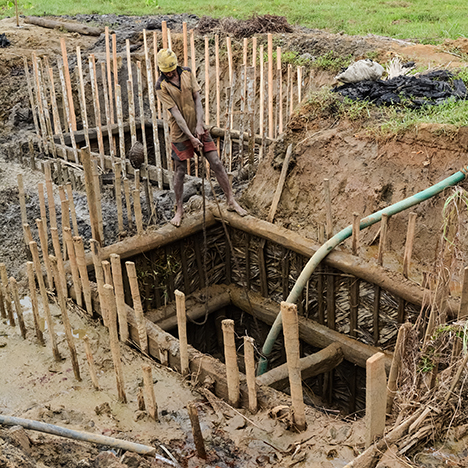To visit Sri Lanka is to experience one of the great gem sources and trading centers in the world. This country has a rich, almost unparalleled tradition and remains vitally important to the modern gemstone market. Sri Lanka has a true mine-to-market industry, both domestically and for export. Its evolution over the last two decades blends the best of traditional practices with modern technologies and business models.
In this field report, we take you on an expedition to this magnificent island and its remarkable mine-to-market industry.
MINING

Most pit-mining operations in Sri Lanka are relatively small vertical shafts. Mining relies on human muscle power and not mechanization.
Mining licenses in Sri Lanka are regulated by the National Gem and Jewellery Authority (NGJA). Of the more than 6,500 licenses issued in 2013, more than 6,000 were for pit-mining operations using traditional methods. The remainder went to river and mechanized mining. Licensing for mechanized mining follows very strict guidelines, and only about ten were issued in 2013.
Many of the licensees have four to five traditional mining pits on their property. It’s estimated that more than two million pits have been dug over the last 50 years. Compared to gem mining in many African countries, there are hardly any unfilled, abandoned pits. This is partly because the National Gem and Jewellery Authority (NGJA) collects a cash deposit when a license is issued. If the mine owner does not rehabilitate the land after mining is complete, the NGJA uses the deposit money for that purpose.
There are usually several people involved in the venture, including the landowner, the holder of the mining rights, the person who supplies the water pump to remove water from the pit, and the miners. They all receive a share of the proceeds from the sale of the gemstones.
Although not as prominent, river mining is another traditional form of gem mining in Sri Lanka. Rivers in gem-producing areas can contain alluvial deposits where the river bends or otherwise slows down. The river miners pick these slow-moving areas in relatively shallow waters and build a dam of wood or rock where the water slows, allowing it to escape from one side while trapping the gravels.
PITS, MUD, GRAVEL, AND GEMSTONES
Gemstone mining in Sri Lanka is mostly from secondary deposits. The gravels yield sapphire, ruby, cat’s-eye and other chrysoberyls, spinel, garnet, beryl, tourmaline, topaz, quartz, and many other gemstones. Sri Lanka’s gem-bearing gravels, called illam, are some of the richest in the world. The island was blessed with geological conditions that provide an ideal blend of chemistry, heat, pressure, time for gem crystals to grow, and weathering for the gem crystals to be deposited and concentrated in gravels.

Besides the well-known Pangaea, which existed about 300 million years ago, there were several other supercontinents in Earth’s early history. Their assembly and breakup cycles helped form most of the world’s gem deposits. Some of these cycles are directly related to gem formation in Sri Lanka.
Assembly of the Gondwana supercontinent was a slow process that took place over millions of years, between 550 and 950 million years ago (Ma), when global forces led to large-scale structural changes in the earth’s crust and upper mantle. The resulting collisions formed the Mozambique Belt, which extends from Mozambique to Ethiopia and Sudan, and also covers most of Madagascar, the southern tip of India, Sri Lanka, and the east coast of Antarctica. Sri Lanka occupied a critical area of Gondwana, and many of its gemstones are believed to have formed between 539 and 608 Ma, a time of peak metamorphism for the area.
Most of the gem deposits are in an area called the Highland Complex, extending northeast to southwest and containing high-grade metamorphic rocks. One major primary sapphire deposit was discovered by accident in 2012 near Kataragama, but it was not producing at the time of our visit, and subsequent mining of the area has produced no commercial yields. A full geological study of the deposit has not been performed, however, so the true potential of this area remains unknown.
Sri Lanka’s commercially important colored gemstone deposits come from weathered alluvial gravels. We visited the mining areas around Ratnapura, Balangoda, and Elahera. Although these make up only a small percentage of the island’s gem deposits, they gave us a representative overview of mining operations throughout the country. All of these were secondary gravel deposits. We did not find any active primary deposits at the time of our visit.
The Highland Complex of Sri Lanka is the most important area for formation of gemstone deposits. Illustration by Peter Johnston, © GIA.

Methods of Gemstone Mining
The mining method applicable is dependent on the mode of Gemstone bearing gravel occurrence. Three main techniques engaged in this process are:
Surface Placer Mining

Pit-Head and Tunnel Mining

Dredging River Bed Mining


